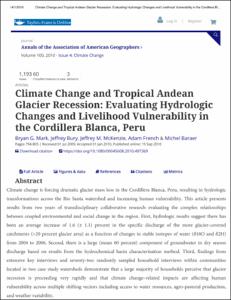Mostrar el registro sencillo del ítem
Climate change and tropical andean glacier recession: evaluating hydrologic changes and livelihood vulnerability in the Cordillera Blanca, Peru
| dc.contributor.author | Mark, Bryan G. | |
| dc.contributor.author | Bury, Jeffrey | |
| dc.contributor.author | McKenzie, Jeffrey M. | |
| dc.contributor.author | French, Adam | |
| dc.contributor.author | Baraer, Michel | |
| dc.coverage.spatial | Cordillera Blanca | |
| dc.date.accessioned | 2019-01-16T21:12:22Z | |
| dc.date.available | 2019-01-16T21:12:22Z | |
| dc.date.issued | 2010 | |
| dc.identifier.citation | Mark, B. G., Bury, J., McKenzie, J. M. et. al (2010) Modelling the hydrologic role of glaciers within a Water Evaluation and Planning System (WEAP): a case study in the Rio Santa watershed (Peru). Annals of the Association of American Geographers, 100(4), 794-805. doi: https://doi.org/10.1080/00045608.2010.497369 | es_PE |
| dc.identifier.issn | ISSN: 0004-5608, ESSN: 1467-8306 | es_PE |
| dc.identifier.uri | https://hdl.handle.net/20.500.12543/3267 | |
| dc.description | Original abstract: Climate change is forcing dramatic glacier mass loss in the Cordillera Blanca, Peru, resulting in hydrologic transformations across the Rio Santa watershed and increasing human vulnerability. This article presents results from two years of transdisciplinary collaborative research evaluating the complex relationships between coupled environmental and social change in the region. First, hydrologic results suggest there has been an average increase of 1.6 (± 1.1) percent in the specific discharge of the more glacier-covered catchments (>20 percent glacier area) as a function of changes in stable isotopes of water (d18O and d2H) from 2004 to 2006. Second, there is a large (mean 60 percent) component of groundwater in dry season discharge based on results from the hydrochemical basin characterization method. Third, findings from extensive key interviews and seventy-two randomly sampled household interviews within communities located in two case study watersheds demonstrate that a large majority of households perceive that glacier recession is proceeding very rapidly and that climate change–related impacts are affecting human vulnerability across multiple shifting vectors including access to water resources, agro-pastoral production, and weather variability. | es_PE |
| dc.description | Artículo en período de embargo | es_PE |
| dc.description.abstract | Sostiene que el cambio climático está causando una dramática pérdida de masa en los glaciares de la Cordillera Blanca, Perú, generando transformaciones hidrológicas en toda la cuenca del Río Santa e incrementando la vulnerabilidad humana. Este artículo presenta los resultados de dos años de investigación colaborativa transdisciplinaria para evaluar las complejas relaciones entre los cambios ambientales y sociales en la región. | es_PE |
| dc.format | application/pdf | es_PE |
| dc.language.iso | eng | es_PE |
| dc.publisher | Routledge | es_PE |
| dc.relation.ispartofseries | Annals of the Association of American Geographers, 2010, Volume 100, Issue 4 pp 794-805 | es_PE |
| dc.relation.uri | https://www.tandfonline.com/doi/abs/10.1080/00045608.2010.497369 | |
| dc.rights | info:eu-repo/semantics/closedAccess | es_PE |
| dc.rights | Attribution-NonCommercial-NoDerivatives 4.0 International | * |
| dc.rights.uri | https://creativecommons.org/licenses/by-nc-nd/4.0/ | * |
| dc.source | Autoridad Nacional del Agua | es_PE |
| dc.source | Repositorio institucional - ANA | es_PE |
| dc.subject | Cambio climático | es_PE |
| dc.subject | Conservación de glaciares | es_PE |
| dc.subject | Riesgos de disponibilidad hídrica | es_PE |
| dc.subject | Monitoreo de lagunas y glaciares | es_PE |
| dc.subject | Efectos de las actividades humanas | es_PE |
| dc.title | Climate change and tropical andean glacier recession: evaluating hydrologic changes and livelihood vulnerability in the Cordillera Blanca, Peru | es_PE |
| dc.type | info:eu-repo/semantics/article | es_PE |
| dc.identifier.doi | https://doi.org/10.1080/00045608.2010.497369 | es_PE |








